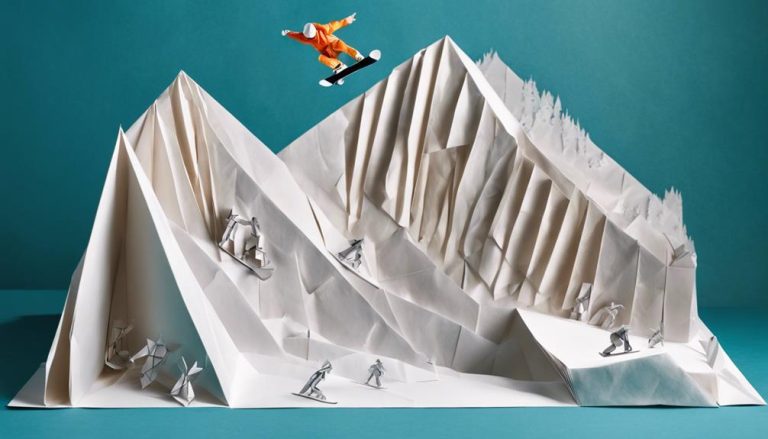General Rules of Ice Racing
To excel in ice racing, prioritize safety with proper gear like helmets meeting safety standards. Securely fasten the chin strap for protection. Inspect your vehicle to make sure safety essentials are in place. Follow race etiquette: start correctly, pass with respect, and understand flag signals. Learn restart protocols for incidents and effective communication. Respect track boundaries with clear markings and regular inspections. Understand penalties for fair play and competitor appeals. After the race, show sportsmanship with gratitude and acknowledge fellow racers' efforts. By mastering these rules, you set yourself up for a thrilling and safe ice racing experience.
Safety Gear Requirements
When ice racing, ensuring your safety involves meeting specific gear requirements. Safety gear importance cannot be overstated in this high-speed, adrenaline-pumping sport. The proper fitment requirements for your safety gear are essential to provide you with the best protection possible.
First and foremost, your helmet is the most vital piece of safety gear. It must fit snugly on your head without being too tight or too loose. Make sure that the chin strap is securely fastened to prevent the helmet from coming off during a fall or collision. Additionally, invest in a high-quality helmet that meets safety standards to protect your head in case of impact.
Next, your racing suit should fit comfortably without restricting your movements. It should be snug to reduce wind resistance but allow you to maneuver easily on the ice. Properly fitted gloves, boots, and protective padding for your knees and elbows are also crucial to prevent injuries during races.
Vehicle Inspection Checklist
To guarantee your safety and the proper functioning of your vehicle on the ice track, conducting a thorough vehicle inspection following a checklist is essential. Before hitting the ice for a race, you must make sure that your vehicle meets the tech inspection requirements. This includes checking the brakes, steering, suspension, tires, and overall structural integrity of the vehicle. Any leaks, loose parts, or damaged components should be addressed before racing to prevent accidents and maintain peak performance.
In addition to the tech inspection requirements, it is vital to have the necessary safety equipment essentials in place. This includes a certified helmet, fire-resistant racing suit, gloves, and shoes. Make sure all safety equipment is in good condition and fits properly to provide maximum protection in case of a crash or spin-out on the ice.
Starting Procedure Guidelines
Prior to beginning the race, make sure you are familiar with the starting procedure guidelines to kick off the ice racing event smoothly and safely. At the starting line, it's important to maintain proper etiquette. Position your vehicle correctly, ensuring it is within the designated area and aligned parallel to the track. Avoid aggressive maneuvers or unnecessary revving, as these actions can lead to accidents before the race even begins.
When the signal is given to start, remember to accelerate smoothly and steadily. Sudden bursts of speed can cause loss of traction on the icy surface, leading to spins or collisions with other vehicles. Gradually increase your speed while maintaining control of your vehicle, especially in the initial moments of the race when congestion around the starting line is high.
Passing Rules on the Ice
As you navigate the icy track during an ice racing event, understanding the passing rules is essential for a safe and competitive race. When it comes to passing on the ice, following passing etiquette and displaying sportsmanship is paramount for a fair and exciting competition. Here are some key points to keep in mind:
- Passing Etiquette: Always respect your fellow racers while attempting to overtake them. Avoid aggressive maneuvers that could endanger other participants.
- Sportsmanship: Show good sportsmanship by acknowledging clean passes and avoiding unnecessary contact with other vehicles. Fair play is fundamental in ice racing.
- Strategic Overtaking: Plan your overtaking moves carefully. Look for opportunities to pass in sections of the track where you can maintain control and avoid risky situations.
- Fair Play: Remember that fair play is at the core of ice racing. Play by the rules, and aim to win through skill and strategy rather than aggressive tactics.
Flags and Signalling System
Now let's tackle the vital aspect of flagging in ice racing. Understanding the meaning behind different flag colors, decoding the signaling system, and grasping the importance of flagging are key elements to guarantee a safe and efficient race. So, buckle up and get ready to explore the world of flag communication on the ice!
Flag Colors Meaning
Understanding the flag colors and their meanings is indispensable for participants in ice racing, as they form the basis of the flags and signaling system used during races. Here's a breakdown of the flag colors and their significance:
- Green Flag: Signals the start of a race or the resumption of a session.
- Yellow Flag: Indicates caution, requiring drivers to slow down and be prepared for potential hazards.
- Red Flag: Signifies the race has been stopped due to a serious incident or unsafe track conditions.
- Checkered Flag: Marks the end of the race or session, indicating the winner and concluding the event.
Understanding these flag meanings and following flag signaling etiquette is essential for effective communication and safe racing practices.
Signalling System Explanation
To comprehend the flag signaling system in ice racing, familiarize yourself with the various flag colors and their corresponding meanings. Signal timing is vital in ice racing, as flags are used to communicate essential messages quickly and effectively. Each flag color indicates a specific instruction or warning for the racers on the track. Understanding the flag signaling system enhances communication clarity between race officials and drivers, ensuring everyone is aware of any potential hazards or changes in race conditions promptly. By adhering to the signals displayed through the flags, drivers can adapt their speed and behavior accordingly, promoting a safer racing environment for all participants. Mastering the flag signaling system is key to staying informed and responding appropriately during an ice racing event.
Importance of Flagging
The flagging system in ice racing serves as an essential communication tool, ensuring swift and clear messages reach drivers on the track. When it comes to flagging importance, understanding the signals is vital for the safety and success of the race. Here's why it matters:
- Communication Clarity: Flags provide immediate information about track conditions and potential hazards.
- Safety Awareness: Drivers can adjust their speed and maneuvers based on the signals displayed.
- Race Control: Flagging helps race officials manage the competition effectively.
- Rule Enforcement: Violations or penalties can be communicated through flag signals, maintaining fairness during the race.
Pit Stop Regulations
Mastering the pit stop regulations effectively is essential for optimizing performance during an ice racing event. Pit stops are pivotal moments during a race where strategic decisions can make a significant difference in the outcome. Understanding the pit crew responsibilities and maintaining seamless teamwork dynamics is key to executing successful pit stops. Pit strategy and tire management techniques play a crucial role in determining the overall race performance.
—
| Pit Crew Responsibilities | Teamwork Dynamics |
|---|---|
| Refueling the vehicle | Clear communication |
| Changing tires | Swift coordination |
| Checking vehicle condition | Precise timing |
| Driver assistance | Quick decision-making |
—
Ensuring that the pit crew is well-trained and synchronized is fundamental for achieving efficient pit stops. Clear communication, swift coordination, precise timing, and quick decision-making are vital elements for a successful pit stop. Pit strategy involves determining the best time to pit, while effective tire management techniques can impact the vehicle's performance on the ice track. By adhering to pit stop regulations and implementing sound strategies, teams can gain a competitive edge in ice racing events.
Race Restart Protocols
When it comes to race restart protocols in ice racing, there are key points to ponder. Restart procedures after crashes are vital for maintaining safety and fairness on the track. Communication with racers during these restarts is fundamental to guarantee everyone is informed and ready to resume the race swiftly.
Restart After Crashes
Upon experiencing a crash during an ice racing event, the race restart protocols are crucial to guarantee fair competition and safety for all participants. Here's what you need to know:
- Assess the Incident: Officials quickly evaluate the crash aftermath to determine the extent of damage and potential risks.
- Clear the Track: Safety precautions are taken to remove any debris or hazards from the racing surface promptly.
- Check Racers' Conditions: Before restarting, medical staff assess the drivers involved to ensure they are fit to continue.
- Communicate Restart Procedure: Clear instructions are provided to all racers on the restart protocol to maintain fairness and safety.
These steps ensure a smooth and secure race continuation after a crash incident.
Communication With Racers
To guarantee a swift and coordinated response, racers will be promptly informed of the restart procedures after a crash incident. Driver communication is essential during these moments to make sure everyone is aware of the strategy moving forward. Team coordination plays a pivotal role in determining the tactics to be employed during the race restart. Clear communication channels need to be established not only between the drivers and their respective teams but also among all the participants. Effective communication enhances the overall safety and efficiency of the race, allowing for quick decision-making and seamless execution of race strategies. By fostering open lines of communication and implementing well-defined restart protocols, racers can navigate post-crash situations with ease and continue racing with confidence.
Track Boundary Markings
Markings around the track boundaries are vital for guaranteeing safety and defining the racecourse limits during ice racing events. Properly marked boundaries help racers stay on track and prevent accidents. Here are some key points to ponder regarding track boundary markings:
- Consistent Color Coding: Differentiate the inner boundaries from the outer edges by using contrasting colors. This helps racers quickly identify the track limits even in challenging conditions.
- Reflective Materials: Incorporate reflective materials into the boundary markings to enhance visibility, especially during night races or in low-light conditions.
- Clear Signage: Install clear signage indicating the track boundaries at strategic points around the course. This ensures that racers are always aware of their position on the track.
- Regular Inspections: Conduct regular inspections to ensure that the markings are intact and clearly visible. Any damaged or faded markings should be promptly repaired to maintain safety standards.
Penalties and Disqualifications
When it comes to ice racing, understanding the penalties and disqualifications is essential for maintaining a fair and safe competition environment. The disqualification process in ice racing is pivotal in upholding the integrity of the sport. Penalties are imposed for various infractions such as exceeding track limits, unsportsmanlike conduct, or causing avoidable collisions. These penalties can range from time deductions to outright disqualification from the race.
In the event of a penalty or dispute, race officials carefully review race incidents to determine the appropriate course of action. This review process guarantees that decisions are based on solid evidence and uphold the rules of the competition. Additionally, competitors have the right to appeal any penalties or disqualifications they receive. Appeals are handled with fairness and transparency to maintain the credibility of the sport and provide a platform for resolving disputes.
Understanding the disqualification process, penalties, and the avenues for reviewing race incidents and appeals is essential for all participants in ice racing to ensure a level playing field and uphold the standards of sportsmanship.
Post-Race Etiquette
As you conclude your ice racing event, it is crucial to bear in mind the significance of post-race etiquette. Expressing gratitude to your fellow racers for a good competition promotes sportsmanship and camaraderie within the racing community. Managing disagreements gracefully demonstrates respect for the sport and guarantees a positive racing environment for all participants.
Thanking Fellow Racers
After completing an ice race, it is customary to express gratitude towards your fellow racers for their sportsmanship and camaraderie. This simple act goes a long way in building camaraderie among participants. Here are some tips on how to thank your fellow racers effectively:
- Verbal Appreciation: A simple "thank you" or a compliment on a good race can show your appreciation.
- Handshakes or Fist Bumps: Physical gestures like handshakes or fist bumps are a great way to thank your competitors.
- Acknowledging Efforts: Recognize the efforts of others, highlighting moments of good sportsmanship or impressive skills.
- Offer Help: If someone faced difficulties during the race, offer your assistance or words of encouragement to show your support.
Handling Disputes Gracefully
Steering disputes gracefully after an ice race is essential for maintaining a positive and professional racing environment. Conflict resolution plays a pivotal role in preserving sportsmanship among competitors. When disputes arise, it's important to address them promptly and respectfully. Keep in mind that dispute resolution reflects your professionalism and integrity as a racer. Approach the situation with a calm and level-headed demeanor, focusing on finding a fair solution rather than escalating tensions. Remember that disagreements are a natural part of any competition, but how you handle them speaks volumes about your character. Embrace sportsmanship by showing respect towards your fellow racers, even in challenging moments. By prioritizing dispute resolution and maintaining professionalism, you contribute to a harmonious racing community.
Frequently Asked Questions
Are There Any Age Restrictions for Participating in Ice Racing Events?
When it comes to ice racing events, age restrictions vary. Safety measures are vital, ensuring participants meet requirements. Always check event guidelines as they specify age limits. Stay informed and enjoy the races!
How Are Winners Determined in Ice Racing Competitions?
In ice racing competitions, winners are determined by timing devices that track each racer's performance. Judging criteria evaluate skill and adherence to rules. In case of ties, tie breaker rules are applied, with photo finishes resolving close calls.
Are There Any Specific Tires That Are Required for Ice Racing Vehicles?
When it comes to ice racing, specific tires are like dancers on a frozen stage. Tire regulations are strict for performance and efficiency. Modifications must adhere to guidelines for best grip and control on icy tracks.
Can Spectators Bring Their Own Vehicles Onto the Ice Racing Track for a Test Run?
Yes, spectators must follow safety precautions before bringing their vehicles onto the ice racing track for a test run. Your involvement adds excitement but adhere to guidelines to guarantee a safe and enjoyable experience.
Is There a Maximum Number of Participants Allowed in an Ice Racing Event?
Concerned about Participant safety and event organization? No need to worry. Ice racing events usually have a maximum number of participants permitted to guarantee smooth operations and uphold safety standards. Enjoy the race!






